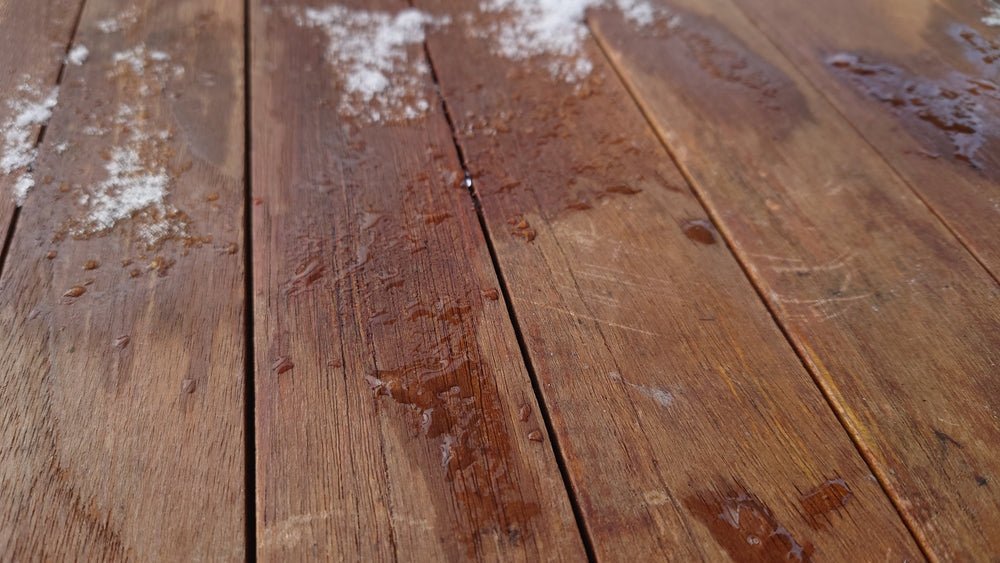
How to Remove Water Stains from a Wooden Outdoor Table Top
Share
Water stains on outdoor wooden tables are a common problem that can make even the most beautiful piece of furniture look neglected. These stains typically appear as white or dark rings and marks, resulting from moisture that has penetrated the wood's protective finish. Fortunately, there are several effective methods to remove these unsightly blemishes and restore your table to its former glory.
Understanding Wood Water Stains
Before diving into removal techniques, it's helpful to understand what you're dealing with. There are two main types of water stains that affect outdoor tables. White water marks occur when moisture is trapped in the finish but hasn't reached the actual wood. These appear as whitish or cloudy spots and are generally easier to remove. Dark water stains happen when water has penetrated through the finish into the wood itself, causing discoloration. These are more challenging but still treatable in most cases.
Cedar Wood Considerations
Cedar is a popular choice for outdoor furniture due to its natural resistance to moisture, decay, and insects. Its inherent oils provide some protection against water damage, but it isn't completely immune to water stains. Cedar has a distinct color that can be particularly susceptible to discoloration when water penetrates its surface. The good news is that cedar responds well to most stain removal techniques, and its natural resilience means it can often be restored to its original beauty even after water damage has occurred. When working with cedar, be gentle with abrasive methods as the wood is relatively soft compared to hardwoods, and you don't want to remove too much material when addressing water stains.
Method 1: Heat Treatment
One of the simplest approaches to removing white water stains is applying gentle heat. Place a clean, dry cotton cloth over the water stain, then set an iron to low heat with no steam. Press the iron on the cloth for just 3-5 seconds, then check the stain – if it's still visible, repeat briefly. Be careful not to apply heat for too long, as this can damage the finish. This method works particularly well on cedar as the heat helps to redistribute the natural oils in the wood while evaporating trapped moisture.
Method 2: Mayonnaise or Petroleum Jelly
This might sound unusual, but it works remarkably well for less severe water stains, especially on cedar. Apply a generous layer of mayonnaise or petroleum jelly directly to the stain and let it sit for at least 1 hour (overnight works even better). Then wipe away with a clean cloth and buff the area gently. The oils in these products help to displace the moisture and restore the wood's appearance while complementing cedar's natural oils.
Method 3: Vinegar and Olive Oil
For slightly tougher stains, this natural remedy can work wonders. Mix equal parts white vinegar and olive oil, then apply the mixture to the stain using a soft cloth, rubbing in the direction of the wood grain. Let it sit for about an hour, then wipe away excess and buff with a clean cloth. This method is particularly effective for cedar as the vinegar helps remove the stain while the olive oil conditions the wood and enhances cedar's natural warm tones.
Method 4: Baking Soda Paste
Baking soda's mild abrasive properties make it effective for more stubborn stains. Mix baking soda with a small amount of water to create a paste, then gently rub the paste into the stain with a soft cloth, following the wood grain. Wipe clean with a damp cloth and dry thoroughly. When using this method on cedar, be especially gentle as cedar is softer than many other woods and can be scratched if too much pressure is applied.
Method 5: Oxalic Acid (Wood Bleach)
For darker, set-in water stains, you may need something stronger. Purchase oxalic acid (wood bleach) from a hardware store and follow the manufacturer's instructions for mixing with water. Apply to the stained area with a brush, let sit for 10-20 minutes, then rinse thoroughly with water and allow to dry completely. This method can be effective on stubborn stains in cedar, but be aware that it may lighten the natural color of the wood somewhat. Always wear gloves and eye protection when working with oxalic acid, and ensure good ventilation.
Method 6: Fine Sandpaper
For deep stains that resist other treatments, light sanding may be necessary. Lightly sand the affected area with very fine-grit sandpaper (220 grit or higher), sanding only in the direction of the grain. Start with gentle pressure and increase only if needed. This approach requires special care with cedar, as it's a relatively soft wood that sands away quickly. After sanding, wipe away dust with a damp cloth, allow it to dry completely, and re-apply wood finish to match the surrounding area. This method requires refinishing the sanded area, so it's best used as a last resort.

Preventing Future Water Stains
Once you've successfully removed the water stains, take steps to prevent recurrence. Apply a quality outdoor wood sealer specifically formulated for cedar to protect against moisture while allowing the wood to breathe. Reapply sealer annually or according to the manufacturer's recommendations. Use coasters and placemats under glasses and dishes, and cover your table during heavy rain or winter months. Wipe up spills immediately when they occur, and consider applying furniture wax for additional protection. Cedar benefits from regular maintenance to preserve its natural beauty and water-resistant properties.
Final Thoughts
Water stains don't have to mean the end for your wooden outdoor table, even one made of cedar. With patience and the right approach, you can often restore the wood to its original beauty. Always start with the gentlest method and progress to stronger solutions only if needed. Cedar's natural resilience makes it forgiving to work with, but its softer nature means gentle handling is important during the restoration process.
